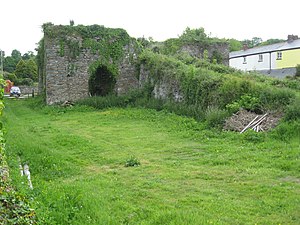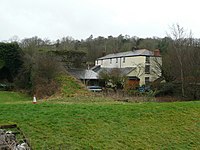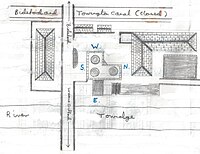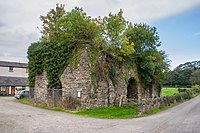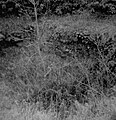Annery Kiln
The Annery Kiln is a disused limekiln of the estate of Annery in the parish of Monkleigh in north Devon. Its remains stand, overgrown, on the left bank of the River Torridge near Half-Penny Bridge, a bridge built in 1835[1] to connect the parishes of Monkleigh and Weare Giffard.
Running by the kiln today is A386 road from Bideford to Great Torrington.
Weare Giffard is the start of the tidal section of the River Torridge, and thus the kiln was sited here to import by river raw materials for the kiln, the product of which was lime fertiliser for use on inland agricultural fields. The old lime kiln is thus situated between the River Torridge and the now filled-in Rolle Canal built around 1827[2] and railway that ran formerly from Bideford to Torrington, opened in 1872 and closed in 1966.[3] The old trackbed now forms a stretch of the Tarka Trail, a walking and cycling route.
Contents
History
Weare Giffard is near the tidal limit of the River Torridge, and coal and before the Rolle Canal was dug in 1823-1827, limestone had long been brought up-stream by boat.[4] Due to the corrosive properties of quick lime, the product of the kiln, it was essential that kilns should be situated as closely as possible to the agricultural fields on which it was to be spread. Should the quicklime become wet during transport by the farmer to his farm, it would corrode its container and damage the wagon or pack-animal on which it was being transported. Culm, a form of imperfect anthracite, was mined in Devon at Tavistock and Chittlehampton as well as being imported from Glamorgan and Pembrokeshire by way of Bideford.[5] The limestone largely came from Caldey Island off the coast fo Pembrokeshire,[4] although Devon itself had quarries at Landkey, Swimbridge, Filleigh, South Molton and Combe Martin.[5]
The lime kiln complex comprised the kiln itself, a pond for slaking the calcium oxide from the kiln to produce the slaked lime, hydrated lime, or pickling lime. Several cottages were built nearby for the lime-burners, shipbuilders and blacksmiths, etc. and storage buildings. The main set of cottages are neither evidenced on any maps nor in census returns until after 1851, indicating that they were not built until later and only one census return in the 19th century lists a lime-kiln worker. A small wharf on the river allowed for the unloading of sailing barges.
The Annery limekiln has a ramp facing the river, three kilns (or burning 'pots'), seven entrance doorways and nine lower apertures for the removal of the calcined limestone. The arrangement of the kilns gives an L-shaped compact structure. Some of the entrances led to arched lobbies or 'eyes', at the back of which were the grates and separate 'poking holes' to insert metals rods for 'working' the charge and helping with aeration. A 'lean-to' slated roof may have slotted beneath part of the drip course of projecting stones, which runs around the exterior walls of the kiln. The arched entrances to the kiln allowed for the sheltered and safe collection of the quicklime, which reacted violently to water.
The top of the kilns was flat and large enough to allow for some storage of culm and limestone. Like Lord Rolle's kilns at Rosemore, Great Torrington and his nearby Town Mills they were at a late date crenellated with castle-like battlements,[6] an eccentric decorative feature probably added by John Rolle, 1st Baron Rolle (d.1842), of Stevenstone, lord of the manor of Great Torrington, builder of the Rolle Canal and partner in the building of Half-Penny Bridge with Mr Tardrew of Annery. Town Mills were crenellated to form an "eye-catcher" when viewed up the picturesque Torridge valley from Castle Hill, Great Torrington, which Lord Rolle had also castellated to recall the ancient castle. The original Annery kiln had been built prior to Lord Rolles's canal and the Great Torrington lime kilns; it is unlikely to have had the crenellations.
Annery was well built, with local mortar-cemented stones, a rubble infill and firebricks lining the kilns' combustion chambers.[5] The various openings to the kilns have rounded or pointed Gothic arches formed from bricks. The now lost crenellated 'battlements' construction was similar to other kilns such as those at Yeo Vale on the Torridge, south-west of Bideford and those at Torrington.[7]
Evidence suggests that the original kiln had a single pot and arched entrances leading to three 'eyes', and that later two more pots were built with rounded tops to the arches which led to only two eyes each.[6] The decorative front of the new kiln has blind arches at either end and two quatrefoils, symmetrical shapes which form the overall outline of four partially overlapping circles of the same diameter.
The kiln had excellent communications, originally being sited simply next to the river, but gaining later the additions of the canal, the road between Bideford and Torrington, as well as the new Half-Penny toll-bridge across the Torridge to Weare Giffard, built in 1835 by Lord Rolle and Mr Tardrew.[1] In Devon the demand for agricultural lime in the 19th century was very high, and farmers from a wide area collected loads of lime from Annery, by pack-horse at first and later using wagons,[4]
The development of the rail network made local small-scale kilns generally unprofitable, but Annery had closed in around 1864, before the local railway was opened. Local competition from the lime kilns at Torrington and elsewhere would have been intense.[5]
Annery Kiln in 1971
Limekiln drawings gallery
A series of drawings was produced in 1971, with only approximate measurements:
Later history
Annery is a nearby former historic estate. Old maps show that a country house of that name existed there in the 18th century. Another lime kiln existed opposite Weare Giffard and the name was either used to distinguish the two or Annery may have been the manorial kiln which supplied the tenants.
During a visit to Annery Kiln in 1971 one of the old cottages had a chimney fire. The householder sorted the problem out by firing both barrels of a 12 bore shotgun up the offending chimney, extinguishing the fire whilst at the same time 'cleaning the chimney!'[5]
In the 1970s the kiln was used as a garage and store (see photographs) and was a community in its own right, known as Annery Kiln.
The small shipyard that had existed at Annery was moved down to the sea lock when the canal was built.[8]
William Tardrew of Annery was a share holder in the Rolle Canal Company and held lands along the length of the canal.[8]
Adjacent to the Annery kiln is Brick Marsh, which was the site of the Devon or Annery Pottery.[8]
The Beam Aqueduct no longer carries the cnala and has long since been used as a road bridge to a private house. Several pivotal scenes for the film Tarka the Otter were filmed below it.
Outside links
Location
- Location map: 50°59’5"N, 4°11’30"W
References
- ↑ 1.0 1.1 Scrutton, Sue, Lord Rolle's Canal, Great Torrington, 2006, p. 23.
- ↑ Minchinton, Walter: 'Devon at work: Past and Present' (David & Charles, 1974) ISBN 0-7153-6389-1, p 82.
- ↑ Mitchell, V. & Smith, K.: Branch Lines to Torrington' (Middleton Press, 1994) ISBN 1-873793-37-5
- ↑ 4.0 4.1 4.2 Hadfield, Charles: 'The Canals of South West England' (David & Charles, 1967)
- ↑ 5.0 5.1 5.2 5.3 5.4 Griffith, R. S. Ll.: 'Annery Kiln, Weare Giffard' (Grenville College project, 1971)
- ↑ 6.0 6.1 the History of Weare Giffard.
- ↑ Minchinton, Walter: 'Devon at work: Past and Present' (David & Charles, 1974) ISBN 0-7153-6389-1, p 38
- ↑ 8.0 8.1 8.2 The Rolle Canal Company
